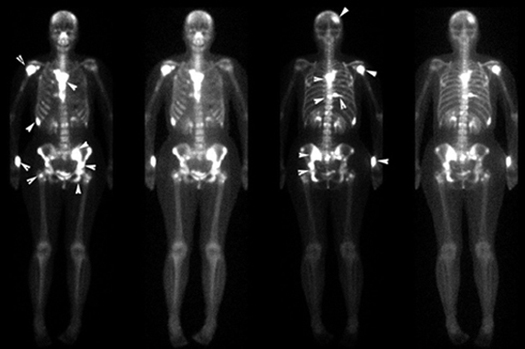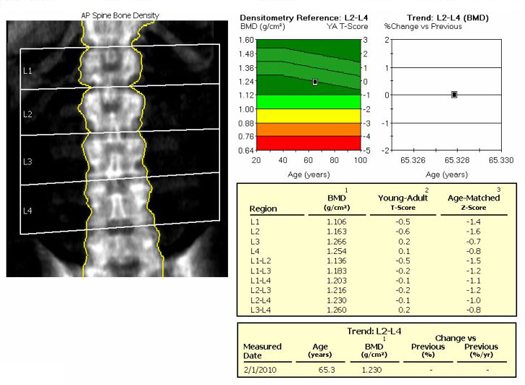
Figure 1: Bone scan
Bone Metastasis: Role of Radioisotope Bone Scan
Case 1:
Patient with breast cancer presents with multiple sites of pain.
Imaging findings: Figure 1
Increased isotope accumulation by metastatic lesions (arrow heads) from breast cancer.
Radioisotope Bone Scan
- Radionuclide bone scanning is the preferred method for evaluating the entire skeleton for the presence of multiple lesions.
- Excellent screening modality.
- Reflects the metabolic reaction of bone to the disease process, with preferential uptake of the tracer at sites of active bone formation.
- More sensitive than plain films for detecting metastasis.
- Metastases are usually multiple, irregularly distributed foci of tracer that do not correspond to any single anatomic structure.
- Bone scans are also limited by a lack of specificity, with most false-positive results due to trauma, whether or not recalled by the patient.
- As a result, the diagnosis of metastatic bone disease usually requires radiographic confirmation.

Figure 2
Bone Mineral Density (BMD)
Case 2:
68 year old woman being evaluated for risk for osteoporosis and bone fractures.
BMD test is the best way to identify patients with osteoporosis, determine risk factors for fractures and measure response to osteoporosis treatment.
A DEXA scan measures your bone mineral density and compares it to that of an established norm or standard to give you a score.
What is a T-score? T-SCORE = the number of standard deviations the bone mineral density measurement is above or below the YOUNG (30 year old) - NORMAL MEAN bone mineral density. Patients BMD - Young adult Mean BMD / Standard deviation of young adult BMD
What is a Z-score? Z-SCORE = the number of standard deviations the measurement is above or below the AGE -MATCHED MEAN bone mineral density. Patients BMD - Peer age group Mean BMD / Standard deviation of peer age group BMD
How do you use T and Z scores in clinical decision? A bone mineral density more than 2.5 standard deviations below the mean for a young healthy adult white woman identifies 30 percent of all postmenopausal women as having osteoporosis; half of these women will already have had a fracture.
- -1 to +1 is normal range
- -1 to -2.5 is osteopenia
- -2.5 is osteoporosis
The hip T-score is the site used in clinical decisions. It is used in premenopausal women. Z-score is less commonly used but may be helpful in identifying persons who should undergo a work-up for secondary causes of osteoporosis. Z-score is useful in postmenopausal women.
This patient has L2-L4 T-score of -0 (normal range).
Findings consistent with normal bone density.